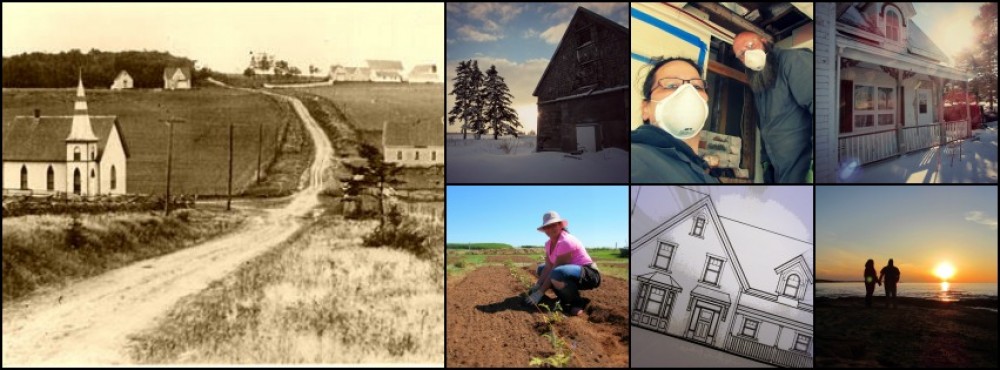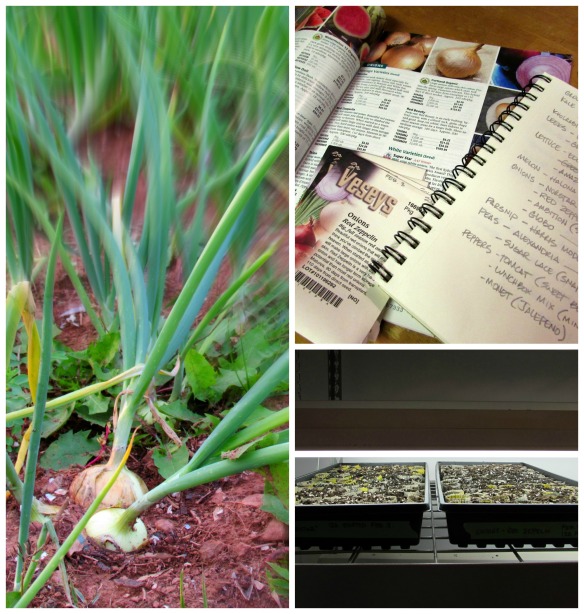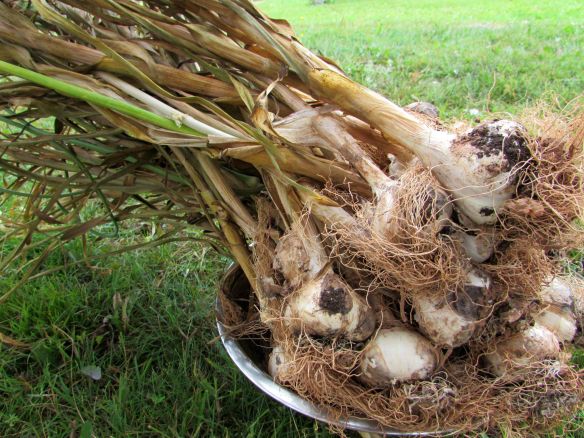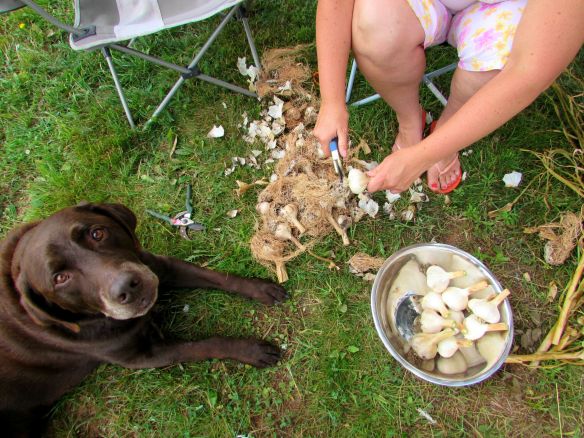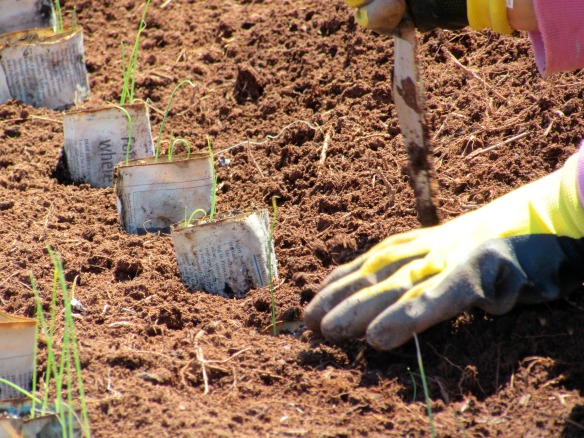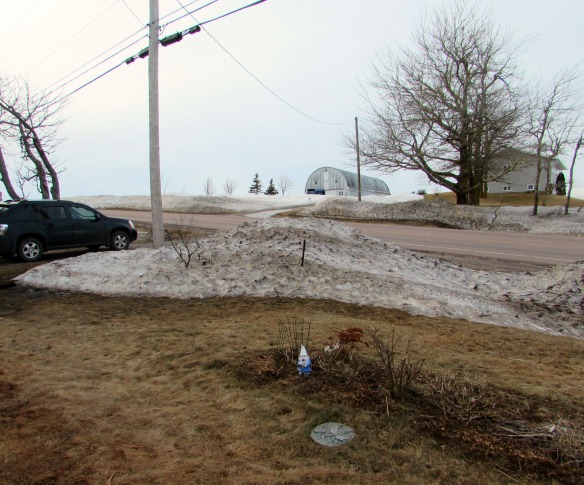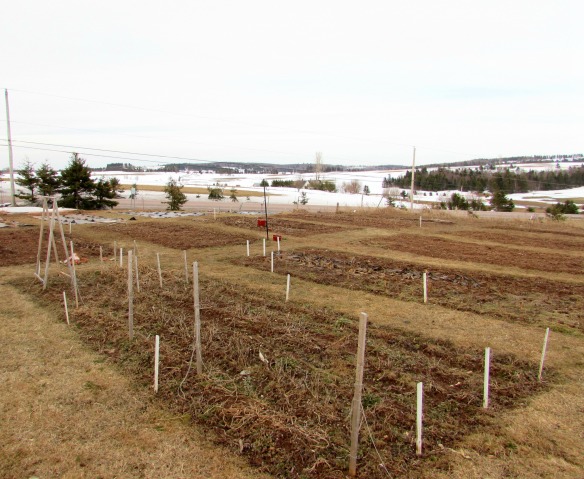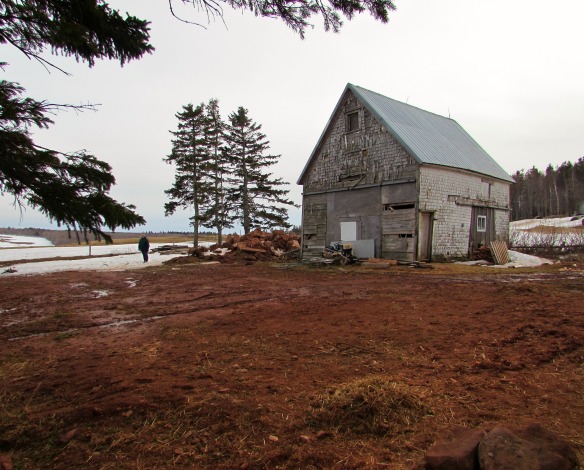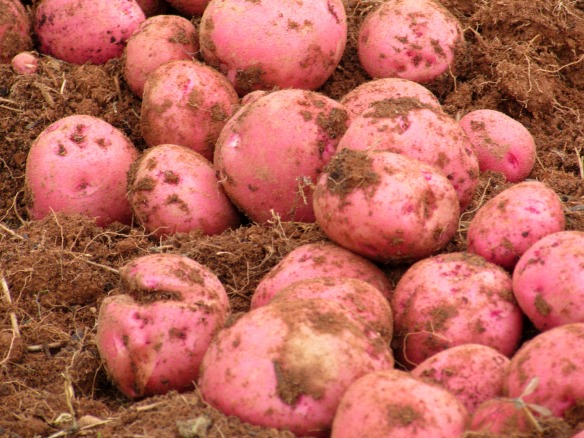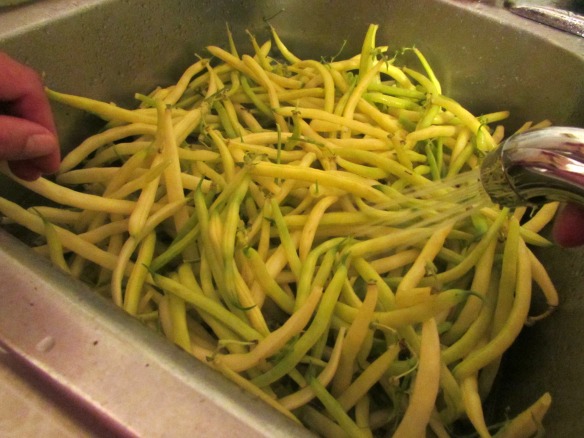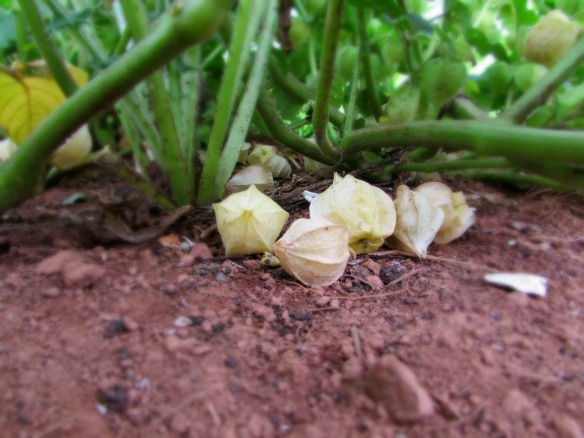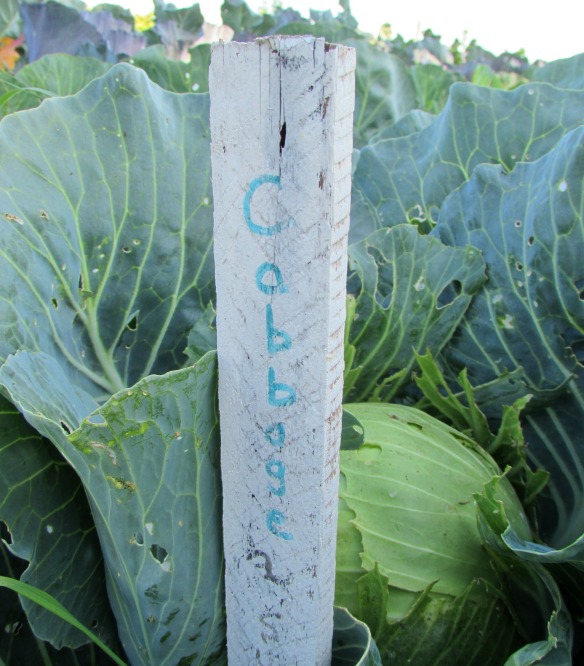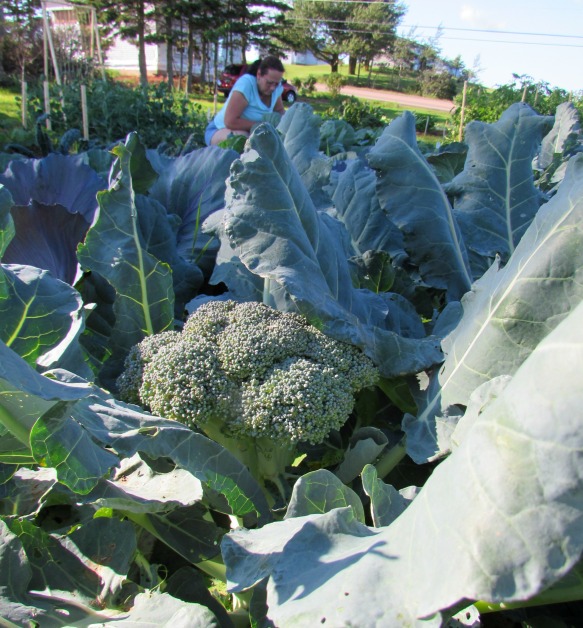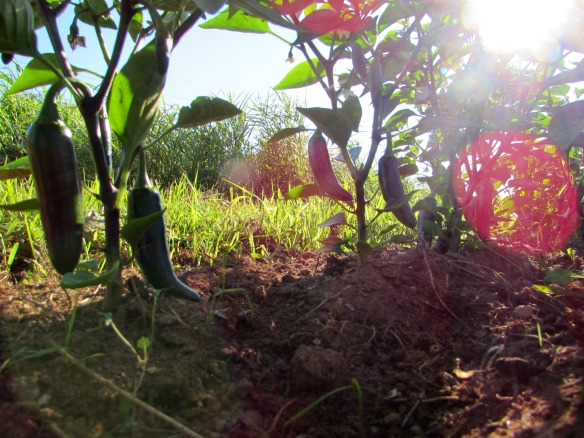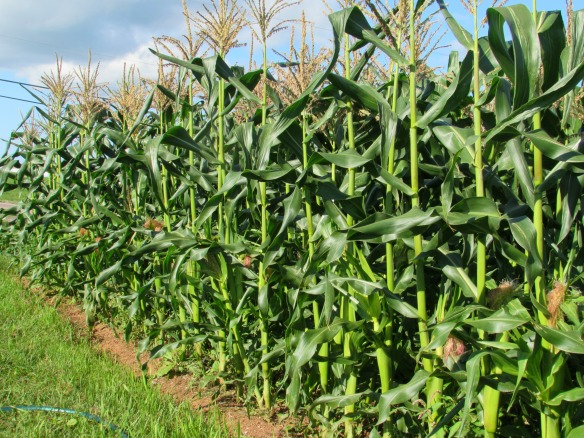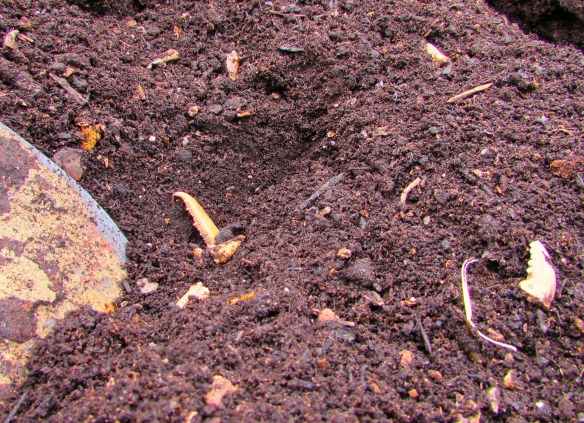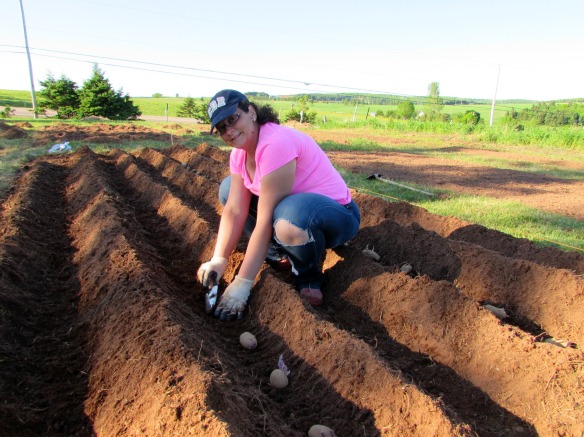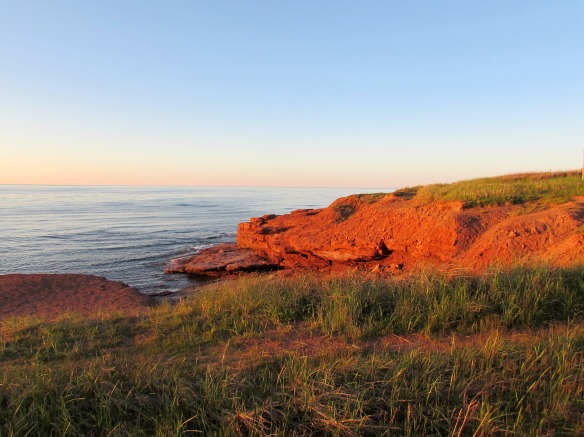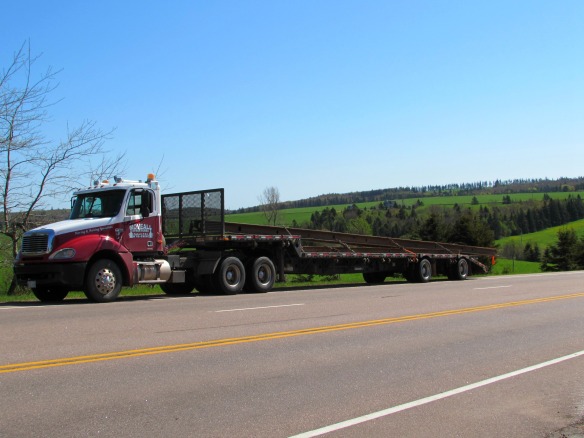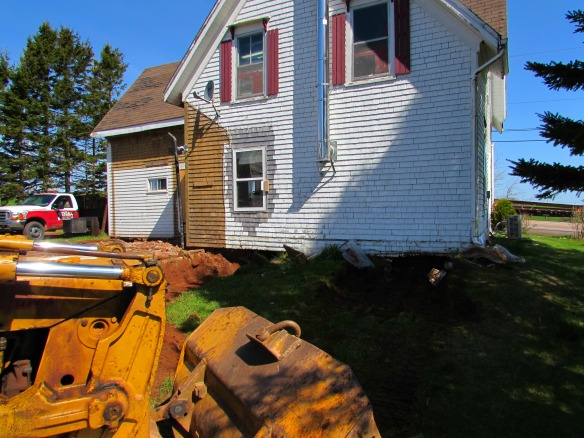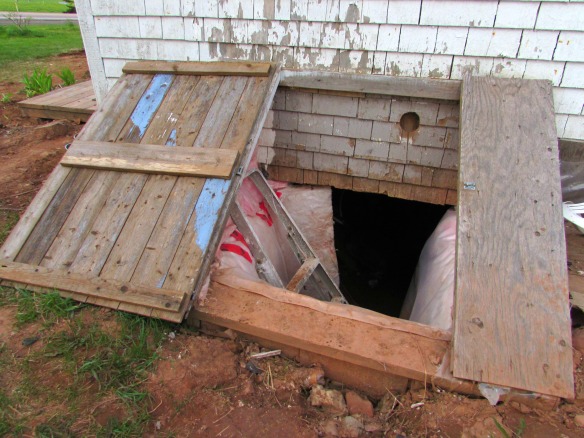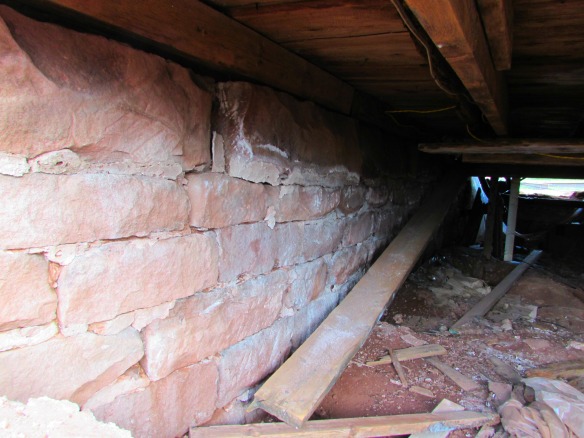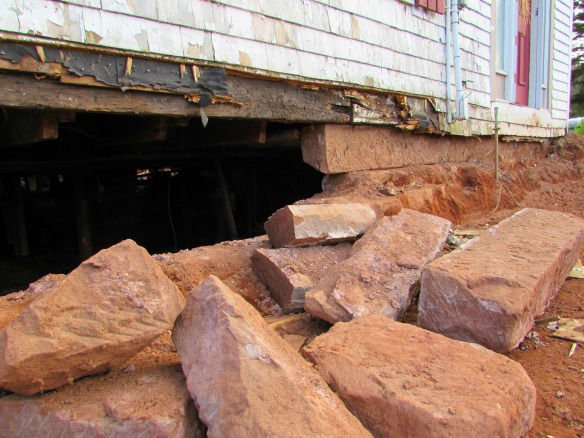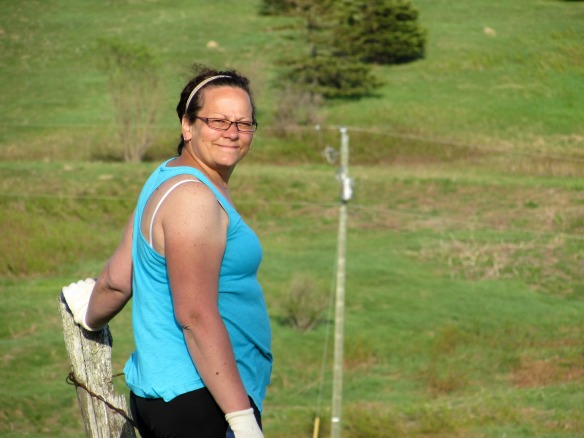A much earlier start for our onion seeds this year. We’re expecting more/bigger/better onions this year!
Tag Archives: planting
All work and no play….
….makes for a dull blog?
For what it’s worth, I’ve written several updates since my last post. Unfortunately they’re tucked away in the recesses of my brain waiting patiently for someone to shine a flashlight into the void, guiding their way out the darkness and onto your computer screen.
Until then, I humbly offer the following review of our summer.
My last post was full of anticipation for the upcoming growing season. Now we’re enjoying the early fruits of our labor and impending harvest.
For weeks now, the zucchini have been growing to mammoth proportions (which we’re processing into zucchini relish) and the zucchini we rescue from that fate end up on the grill with a little olive oil, sea salt and cracked pepper. Mmmm.
We harvested all of our garlic a few weeks ago, pulling them from their beds and hanging them to cure.
Each “leaf” of the garlic represents a layer of the paper surrounding the cloves. While the garlic is ready to use after harvesting, it’s important to dry the heads in order to store them for an extended period.
We let them cure for a couple of weeks in the warm, unfinished second floor bathroom of our home. Once sufficiently dry, we clipped the leaves and roots and have them ready to use for the next few months.
The beauty of growing our own garlic (aside from, you know, eating it) is that we have all we need to plant and grow next years’ supply. We’ll set aside the largest and best garlic heads and plant those cloves this fall for next summers’ harvest. Fresh food is awesome. FREE, fresh food is awesomer.
We’ve had a beautiful summer. Although dry, it’s been downright hot for weeks. The tomatoes are thriving and just starting to show signs of their maturity.
The peppers are plumping and the potatoes are nearing their harvest time. We’ve had one crop of peas already picked, another almost ready and a third crop growing for a fall harvest. Likewise with the carrots, beans and beets. Squash and pumpkins are flourishing in our lasagna beds and our second planting of cauliflower, broccoli, kale, collards and kholrabi will be ready in a few weeks.
Aside from the gardens, our flock of hens grew by six this summer.
Violet, Pansy, Dahlia, Sunflower, Petunia and Lily have joined the Golden Girls – and at 18 weeks of age, they should start fulfilling their end of the bargain and begin to give us a daily egg each.
We had the pleasure of having my Mom visit for the majority of July. As much as she was looking forward to a visit, I think we enjoyed it as much or more.
Well, we certainly enjoyed exploring and discovering new restaurants and shops that Vanessa and I intended to (but never have) tried. But more than that, we just enjoyed the company.
Vanessa and I both are working full-time at new jobs. I’ve been working for a disaster restoration contractor for the past several months. Although I have to admit, after a long day (or week) of working on other people’s homes and properties, it’s hard to find the motivation to do the same for ourselves. Vanessa is now at Cavendish Farms processing one of PEI’s most famous commodities: potatoes! It’s actually working out very well for us. I work a fairly typical work-week: Monday to Friday with occasional evening or weekend projects. Vanessa works two day shifts, two night shifts and then has four days off. Those four days have proven invaluable to us as she’s able to tend to things around the homestead (like curing garlic and raising chicks).
So. There you have it. Sort of. Its hard to wrap up three (four?) months in 600-or-so words, but I think I managed to empty out a few things rattling around in my head. I’ll do all I can to right-this-ship and resume my regular updates. It’s looking like an exciting fall around our old island home. Just do me a favor and let me know you’re still out there. I get a lot of my motivation and inspiration after hearing from you.
Thanks – and blessings from our home to yours!
It’s the most wonderful time of the year…
Exodus 23:25 – “Worship the Lord and his blessing will be on your food and water.”

The best place to greet spring is in the garden and like every year, as soon as winter’s grip is loosened, Vanessa and I grab a shovel and pitchfork and head outside.
Spring marks winter’s (long overdue) departure and the awakening of – well, everything. The birds are back, the frogs are “peeping” from the creek down the hill from our home and plant life is bursting in anticipation of another growing season. All of this makes spring my favorite time of year.
Back in March, we started our onion and leek seeds. As soon as the ground is workable, these frost-hardy plants can be transplanted into the garden. If we were able, we probably would have planted these out a couple of weeks ago – even the end of April isn’t too soon – although the weather wasn’t as agreeable.
This year we planted about 100 plugs – and each plug has at least two or three seedlings. We’ve learned the onions can be planted in small groups, given enough space between groupings, and the onion bulbs will form without any problem. This saves a tremendous amount of time in planting – and eventually harvesting, as it takes the same time to plant a one-seedling plug as it does a three-seeding plug.
We adjust the spacing between the plants to accommodate the groupings. Individual onions would be planted about 3-4″ apart. We keep our groupings spaced about 8″ to allow for the plants to bulb when they mature.
Our leeks are planted similarly – with two seedlings in a pot. With the leeks, though, we dig a deep hole about 6-8″ deep and drop the whole newspaper pot in it.
As the plant grows up and out of the hole, the soil will be gradually filled in, thereby keeling the lower part of the leek white: a process called blanching.
And it’s just amazing to watch the garlic grow – seemingly right before your eyes.
So while Vanessa was planting the onions, garlic and leeks in one bed, I started preparing another bed for a different crop.
Last year, we ran out of space for our broccoli, cauliflower, kale, collards and cabbage. This year, we’ve dedicated two beds for these cruciferous veggies. This weekend we planted our cauliflower, broccoli, kholrabi, kale (two types), collards, turnips, rutabagas and cabbages.
In the other bed, we’ll plant additional broccoli and cauliflower every couple of weeks for a continuous supply of fresh vegetables, along with brussels sprouts, cabbage and whatever else we’d like more of.
In addition to planting out some of the seedlings we started inside to get a jump-start on the season, we directly seeded our peas (snow peas, sugar snap peas and a shelling pea), carrots, beets, radishes, spinach and swiss chard.
All these plants can be started a few weeks ahead of the last expected frost date without any concern. Other vegetables like tomatoes, peppers, squash, corn and cucumbers are heat-loving and wont tolerate even a light frost, so we’ll wait until June before introducing these to the garden.
The chickens are happy and doing their thing. 
Murdoch is just content to be a part of whatever we’re doing. 
Even Jill and James come over to see what we’re up to.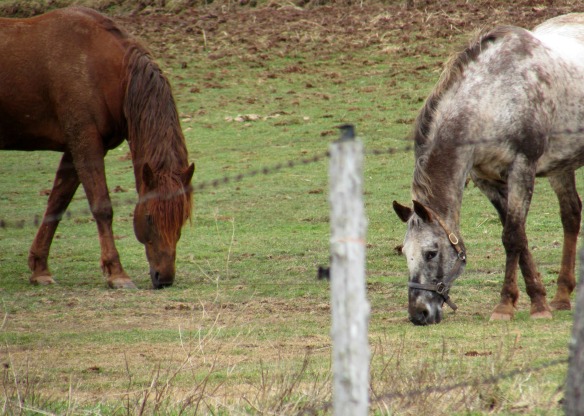
Sprung!
Yes, it’s been a while. A few of my loyal readers (there are a few) have been asking what’s going on. Well, I’m here to tell you.
Winter. That’s what’s been going on. And I believe this winter has been going on for almost 42 months.
But as predicted in my last post, the inevitable has happened. Spring.
I’ve never been happier to have muddy boots. Snow Mountain is eroding and the gardens are almost bare. We’ve been trenching some waterways for the melting snow to run. It’s been helping keep water away from the house and our walkways somewhat clean. Until we grade the property and seed our lawn later this year, the mud will be an ever-present companion.
Having said that, the ground is slowly firming up – at least where we need it to be. And more importantly, the food gardens are clearing up, too. Hopefully, if the weather stays nice, the ground will dry out sufficiently for us to plant a few things.
As soon as the ground is workable, we can plant out the onions and leeks we started a few weeks ago. They’re coming along nicely under our grow lights – as are the broccoli, cauliflower, peppers, tomatoes, cabbage, kale and kohlrabi. Soon we’ll be starting the squash and cucumber seeds as the risk of frost will have to be completely passed before they can be planted out.
The chickens have been enjoying some new-found-freedom since they’ve been confined in their coop for the duration of the winter. Our effort to catch the resident weasel has been fruitless. For the chickens protection, we kept them inside the coop until the past couple of weeks.
With the weather warming and other food opportunities present, we’re taking our chances that the weasel will leave them alone. While there was snow on the ground, we could see his tracks throughout the barn. I’m sure he’s been keeping the mouse population in check and with the arrival of the migratory birds, hopefully it will have it’s choice of sparrows, starlings and pigeons – all of which have taken residence in our barn loft.
So that’s what’s happening around the homestead. On another note, we’re in the midst of the second work-layoff this winter. Earlier the year, the mussel harvesters couldn’t get onto the ice because of the copious amount of snow . Now the issue is the deteriorating ice conditions. Ice harvesting isn’t an option now so the fishermen are just waiting for the ice to clear enough to launch the boats.
That put a halt to some of our plans this spring. We were to visit Ontario for a friend’s wedding but had to cancel with the unexpected income interruption. But on the other hand, it has freed up some time to do a little work around the house.
We lifted the underlayment in the bathroom and repaired the subfloor. Soon, I’ll be roughing in the plumbing for the fixtures and hanging some drywall. Of course, we’ll need to get back to work soon to afford the next few steps.
But for now, we’re enjoying the time off and the milder weather. Soon, spring will turn to summer and this record-breaking winter will be a distant memory.
Gardening. It’s cheaper than therapy.
There’s an old proverb that says, “no matter how long the winter, spring is sure to follow.” This weekend sure felt like it had finally arrived.
We took a short drive through Cavendish, enjoying the sun and fresh air, and spotted this guy on the edge of the ice at Wheatley River.
We actually saw three of these bald eagles on our drive today but this was the only one we managed to photograph.
With spring only a couple of weeks away, our thoughts have been turning to the gardens and our seed starting schedule.
Depending on who you talk to, our last spring frost is typically expected sometime in the last week of may or first part of June. So with about twelve weeks before the last frost of the year, we need to start some of our seeds in anticipation of planting out when the soil is workable
First up are our leeks and onions. We’ll start the seeds this week, giving us about eight to ten weeks head start before planting them into the gardens. Onions and leeks are fairly cold-tolerant, so we will transplant them two to three weeks before the last spring frost date – sometime in early May.
Over the next few weeks, we’ll also be starting our broccoli, cauliflower, pepper and tomato seeds.
We experienced a steep learning curve last year when planning and planting our gardens. Thankfully we’ve had far more successes than failures, but with everything in life, if we can learn from our mistakes, we won’t be subjected to repeat them again. Careful records of our seeding and transplanting dates last year has taken out some of the guesswork, and we can tweak our schedule to improve our success this year.
I think spring really is my favorite time of year. To me, it feels like the new year actually starts now – when the snow is melting, the soil warms and the trees and plants are waking up from the winter.
I know, I know – we’re not out of winter’s grip yet, but I keep reminding myself that there’s more winter behind us than ahead.
An Early Thanksgiving Harvest
“Look at the birds of the air; they do not sow or reap or store away in barns, and yet your Heavenly Father feeds them. Are you not much more valuable than they?”
Well, it’s clear that we won’t starve this fall. in fact, we’ve been blown away at the bounty of our harvest from our gardens this year. And it’s not over yet!
Over the past couple of weeks, between working on a few projects around the house, we’ve been slowly harvesting our crops as they become ready.
We picked our first variety of sweet corn last week and blanched and froze the majority of it. Yes, we ate a lot of it fresh as well – and we shared a couple dozen among friends and neighbors, too.
The later-maturing variety is almost ready now – perhaps by this time next week. That will be another 90-100 ears to process as well.
I think we can call our potatoes a success, too. We grew four varieties: red, yellow, russet and purple. The Purple Chieftain was the most plentiful – in sheer number of potatoes harvested – although they were probably the smallest ones on average.
After that was the Russet. These turned out a bit smaller than I expected but will be great baked and french fried. The yellow and red were the largest of all.
Each individual potato is a handful. We’ll certainly be growing more of the red ones especially.
All in all, we dug up over 150 pounds of spuds from the ground last week, That doesn’t include the who-knows-how-many pounds of new potatoes we took as we needed previously.
I never weighed the cucumbers and zucchini we grew – but we have pickled almost 30 pints and/or quarts of them.
We’ve also enjoyed fresh green beans and yellow wax beans for the past few weeks but with the plants producing more than we can eat fresh, we picked, blanched and froze the remainder – over fifteen pounds!
But sadly, not everything went so swimmingly. I’ve already written about the issues we had with our tomatoes – then last week a cold snap claimed the sweet potatoes and winter squash plants. Unfortunately, even though we covered the plants that evening, the cold was too much and these plants were beyond recovery.
But, like the second corn harvest, we still have cabbage, rutabaga, carrots, parsnip, onions, pole beans, leeks, beets and swiss chard to pick as needed – and then to harvest for long-term storage as well.
Then we have some of the more unusual crops to enjoy. Like these little guys:
Ground Cherries (or Cape Gooseberries or Husk Berries depending on your preference). A member of the tomato family, ground cherries grow in a little papery husk while on the plant and are ready for harvest when they fall to the ground.
Sweet and juicy and pineappley – I love them over vanilla ice cream.
The berries can be prepared in a tart or pie-shell as well – I’ll let Vanessa take care of that bit of research and let you know.
Other than some fruit, we haven’t bought any produce to speak of since the end of July. And frankly, like most people know of home-grown tomatoes, there’s nothing like picking and preparing vegetables fresh from the garden. And it’s good knowing that there’s no pesticides or chemical fertilizers to worry about.
Today, we did a big cleanup on the harvested beds and planted a cover-crop of buckwheat to replenish some of the nutrients and organic matter in the beds. Left in the bed to die as the cold approaches, it will also help protect the soil from wind-erosion through the winter.
And already, we’re planning what and how to plant the beds next year. Until then we continue to enjoy this bounty.
Thank you, Lord.
Disaster
It was bound to happen sooner or later.
We’ve had our first letdown on our old island farm. And it came in the form of a disease called “late blight”.
Sadly, once infected, the affected plants (in our case, tomatoes) are essentially doomed and destroying these plants is the only hope of preventing it from spreading to other plants.
This disease is famous as the cause of the Irish potato famine in the 1800’s. Phytophthora infestans is not a fungus or a bacterium or a virus. It belongs to a group of organisms called “protists”, although they are still commonly referred to as “fungi”.
On tomato, the first symptom on plants is often a brown/black lesion on the stem. Leaves develop large brown/black blotches, often starting at leaf margins. In humid weather and in early mornings, a fuzzy mould can often be seen on the underside of the brown/black blotches or on the stem lesions.
On tomato fruit, infection causes a brown/black, leathery rot. It may also become soft and mushy if invaded by secondary organisms.
In cool, wet or humid weather the pathogen produces structures called “sporangia”. These sporangia can travel up to 20 kilometers in wind or wind-blown rain. Rain-spread sporangia can cause infection even in a garden where tomatoes or potatoes have not been grown before.
Potatoes are also very susceptible to late blight – hence the cause for concern when it is detected here in Prince Edward Island. Fortunately, our potatoes seem to have come away unscathed. We’ve been enjoying new potatoes daily for a couple of weeks and we’re ready for our big harvest for cold-storage this weekend.
We first heard of a blight-outbreak in our area on the local news. It was just a few days later when we started seeing the signs of infection on our own tomatoes. And once it started, everything went downhill quickly.
With the onset of the disease, we moved to remove the plants and bag them for disposal. It’s strongly recommended that you NOT compost the affected plants as the organisms may not die in the composting process. Burying, burning or sending the plants to the landfill is the best way to rid your garden of the active problem.
Although the plants were dying, we could still use the green tomatoes if we acted quickly. Often with late blight, even green tomatoes brought in the house to ripen may still rot anyway. In wet weather, green fruit may have been infected already, or be carrying spores on the surface. As the fruit ripens, rot develops.
Some gardeners report that washing green fruit in soap and water after picking, or dipping green fruit in a 10% bleach solution (1 part household bleach to 9 parts water) followed by a soap and water wash, reduces fruit rot during ripening. We didn’t take any special measures to allow the tomatoes to ripen – so we did lose quite a lot to rot, but we still enjoyed a few fresh tomato sandwiches in the meantime.
So with the glut of green tomatoes, we spent a couple of days making a few different preserves – Salsa Verde, Green Tomato and Pineapple Chutney and Piccalilli. I’ll be sharing some of these ideas in future posts, but today, it’s all about Green Tomato Chow.
On Prince Edward Island, these firm, under-ripe green tomatoes are transformed into a tangy-sweet condiment that is often served alongside salt cod cakes. I’ve had Green Tomato Chow (or Chow Chow, or Yum Yum, depending on your upbringing) on a couple of occasions since moving to the island. Most recently with crab cakes from the Blue Mussel Cafe in North Rustico. Think of it as a relish, to be served alongside seafood, pork, sausages or even hamburgers.
At any rate, it’s a great way to use up some of your end-of-season green tomatoes – whether by choice or by….blight.
GREEN TOMATO CHOW
- Green tomatoes, sliced – 5-1/2 lbs.
- Onions, halved and sliced – 1-1/2 lbs.
- Pickling salt – 1/3 cup
Layer tomatoes and onion with salt in large pot. Cover and let stand on counter overnight. Drain. Add the following ingredients to the tomato mixture in pot.
- Granulated sugar – 3-1/3 cups
- Mixed pickling spice (tied in cheesecloth) – 4-1/2 tbsp
- Turmeric – 2 tsp
- White vinegar – 2 cups
Heat and stir until sugar dissolves. Bring to a boil then reduce to simmer for two hours, stirring occasionally. More turmeric can be added for color and more sugar can be added for taste.
For canning, pour into hot sterilized jars leaving 1/4″ headspace. Seal and process for 10 minutes in hot water bath. Makes about 4 pints.
So not all was lost. Although our first season growing a variety of tomatoes was a bit of a bust, we have learned a lot. We lost about 90% of the tomatoes we planted. One variety we chose is labelled as blight-resistant, and these “Mountain Merit” tomatoes are chugging along nicely in their beds. So it seems we’ll still be enjoying some red tomatoes after all.
This Chow recipe was inspired by “Company’s Coming – Preserves” by Jean Pare.
I know it’s been a while. A lot has happened.
It’s said: “great things are believed of those who are absent.” If that’s indeed true, I hope I don’t let you down.
It has been a great few weeks since my last post. A lot of things have happened to us and through us. We’ve had a great time visiting with family and enjoying the bounty that’s come from our garden.
My last post spoke of the busy couple of weeks getting the house ready leading up to our vacation. I won’t revisit that, but suffice to say, we enjoyed our little trip to Ontario. Not that is was solely for our amusement – my brother Scott and his fiance Dawn were married. That in itself was reason enough for us to drop everything and head back, but the honor was mine when I was asked to perform their wedding ceremony – to the surprise of everyone in attendance.
It was a beautiful day spent with family and friends.
While in Ontario though, we had a little scare. I ended up in the hospital with a blood clot in my leg. As the doctor said however, I got lucky. The clot was in an arterial vein and I wasn’t at risk of it moving to my heart or lungs – so I was sent on my way with blood thinners to enjoy the rest of the vacation.
Once the newlyweds were married, we all convoyed back to PEI for a “familymoon”.
Scott and Dawn, Scott’s kids Carrie and Ryan, one of Dawn’s daughters, Jordan and her husband Christian, and my Mom spent the week with us to see the life we’ve been making for ourselves.
We did some of the usual touristy stuff – went to the beach (several times), ate some lobster and visited the sights and scenes.
It was hard to see the family leave after only a week here, but we had a tremendous time together.
Vanessa and I weren’t done with the vacation just yet, though. We’ve been mackerel fishing now a couple of times.
I want to take advantage of this as much as we can while the summer is here. There is no catch-limit or license required to catch mackerel here – so while we’re able, we’ll be stocking our freezer with these freebies.
And speaking of freebies, our garden just keeps giving and giving. While our guests were here, we enjoyed produce picked daily from the garden – including broccoli, lettuce, beets, new potatoes and zucchini.
Since our visitors left, the tomatoes are turning, the beans are almost ready and the corn is almost there. We haven’t bought any produce – other than some fruit – in about a month.
What we haven’t been able to eat fresh, we’ve been canning or freezing. We’ve pickled fourteen pounds of beets and have a second crop planted for an early fall harvest.
We’ve also processed fifteen pints of pickles – dill and bread & butter
and have about ten pounds of cabbage fermenting for sauerkraut.
So while we’re not entertaining guests, or fishing, or tending to the vegetable garden we also have our chickens.
We now added six laying hens to our family so we quickly built a brooder for the chicks and Vanessa and I are currently building on a small coop from some of the reclaimed wood from the renovations on the house.
So needless to say our month-long absence is not the result of not having anything to write about, but rather the opposite – we’ve just been too busy to keep up with everything. Hopefully we haven’t lost anyone along the way.
We’ll get back on track, but for now, some pictures from our garden:
Red soil and red sky
So with the foundation work chugging away, we finally have an opportunity to get our gardens planted.
Whenever we had some spare time over the last couple of weeks, we raked the old grass and straw from the garden area, laid-out the bed locations and tilled the soil.
Last week we had a load of compost delivered to our place to help enrich the beds. With time running against us, we didn’t test the soil or composition – we’re just trusting that the fertile soil of PEI doesn’t stop at our property line.
Speaking of fertile PEI soil: I suppose it’s only fitting that even compost in Prince Edward Island would be full of lobster bits.
Once the compost was worked into the bed, it was time to start planting. We started with the tomato beds – all from seeds started earlier this spring.
In all, we’ve planted about twenty-four Roma tomatoes for sauces and canning. In addition to the paste tomatoes, we also planted six each of four Heirloom-varities: Brandywine, Pruden Purple, Mountain Merit and Golden Cherry.
With the tomatoes planted, we jumped over to the potato bed. Not originally planned as part of our garden, the potato bed was a last minute addition.
We never really thought we’d need to grow potatoes in PEI – we’re living in Canada’s potato capital, afterall. Heck, we even have lobster in our soil! So, like everything else, we went all-out and planted four types of potatoes: red potatoes, Yukon Gold, Russet and a purple-fleshed variety.
Before the day was up, we planted two of our berry beds – raspberry and blackberry – and also got our asparagus bed planted.
We’ve never grown asparagus before but have dedicated a 25-foot row for it – although it will still be a few years before we’ll actually be able to harvest spears to eat.
Finally, before we headed out for our drive, we finished up one more bed.
Three types of cabbage, rutabaga, broccoli, broccolini, cauliflower, kale and collards.
All in all, not a bad start on the gardens. We’ve still got the beans and peas to plant, as well as carrots, beets, sweet potato, corn, summer and winter squash, cucumbers, onions, garlic and peppers.
As of late, our backyard is taking on the appearance of a motocross course. As exciting as it is having the foundation-work done, I’m really looking forward to getting the mess cleaned up.
We’re still deciding where to use all of the island stone salvaged from the foundation….
….and exactly how to get it all in place. I do know, it’s going to be a beautifully landscaped property once we get to tackle that pile.
But as the sun was going down, we decided to take advantage of the remaining daylight to go for a walk on the beach. A quick drive from the house and we arrived in Cavendish just in time to watch the sun set.
Still early in the season, we had the beach to ourselves. Tide was low and we walked along the shoreline to take it all in.
I think this was the first time we really stopped to let it all sink in: this is our home. We’re only minutes form the ocean in any direction from our house.
With the sun down, we walked back through the sand dunes to the car.
No matter how crazy the renovations get, we’re exactly where we want to be. With the house. With the gardens. With each other.
The start of something new
At long last, the foundation work is underway. The long, cold, wet spring has put us a little behind schedule but hopefully we’ll make up some time with the nice weather as of late.
Vanessa and I were sitting at the breakfast table last week when this hauled up outside our house.
The huge carrying beams had arrived, the excavator was already delivered – so it was time to get underway.
First, make a cut in the topsoil to provide access to the sills – the first to be replaced. Once all of the old sills are removed and replaced and the walls are re-supported, the house can be lifted and the excavation can start.
So I thought I’d take you on the grand tour of what’s under our house before it all disappears.
The original foundation is hand-cut sandstone, dry-stacked to about 5′ high. The mortar you see in the joints was applied sometime in the past in an attempt to keep some of the moisture out.
All of these stones will be removed and salvaged from the foundation and stored at the back of our property.
A lot of these stones will be used in-and-around our property as part of our landscape design as garden borders, retaining walls, walkways and steps to the deck.
The stones are beautiful – all hand shaped and fit precisely for the foundation – and will have a prominent place in our garden. But still – that’s a lot of rock.
The whole process for the new basement will take a few weeks, but while that’s underway, we’ve kept busy building our gardens. The plants we started inside need to be transplanted so our first job is to build the garden beds.
The areas we’re working in have never been farmed before. Decades of grass growing waist-high and dying back every season has made the digging difficult (to say the least) but because of this, I suspect the soil is going to be very fertile. We’ve easily got a couple more days of digging and tilling the soil before we actually plant anything.
There are some vegetables that should have been planted by now, but with the disagreeable weather and the house demolition monopolizing our time, we will just have to make do.
Fortunately, out seedlings have been thriving inside our grow-op. We’ve slowly acclimated the plants to living outdoors by daily increasing their outside exposure.
Hopefully by this time next week, the veggies will be all planted and we’ll be starting on the new shed/chicken coop.
So, things are looking up. We’re turning that corner that we’ve been waiting for – restoration instead of demolition. We still have a lot ahead of us, but it’s a nice feeling that we’re into a new stage. Until then, though, we continue working in the garden and getting our beds planted. That in itself is like therapy.
